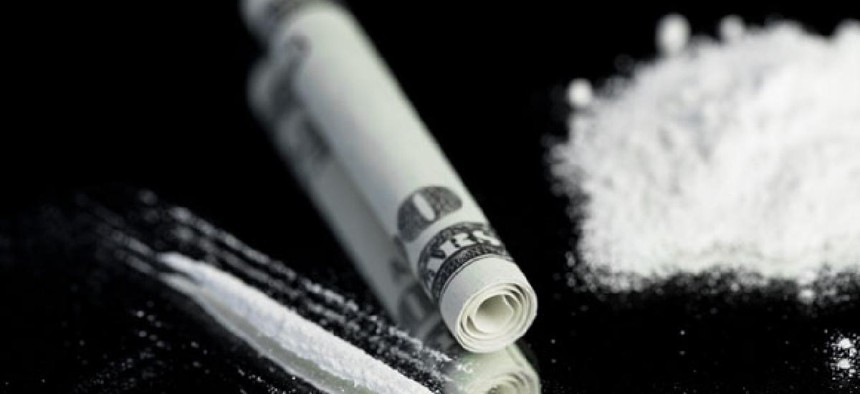Analysis: Losing the War on Drugs
Law enforcement agencies will never stop narcotics trafficking unless they follow the money.
It has been four decades since President Nixon declared a war on drugs. But by conventional standards, the effort has failed. In fact, the Justice Department’s 2011 National Drug Threat Assessment noted “the overall availability of illicit drugs in the United States is increasing.”
During the Nixon era, the importance of following the money became apparent in the drug war. The 1970 Bank Secrecy Act was designed to give criminal investigators better tools to identify proceeds from the sale of illicit narcotics. But while drug interdiction continues to receive recognition and scrutiny, the asymmetric financial battles receive surprisingly little attention.
Criminals traffic in narcotics as a means to an end -- money. The collective federal, state, local and international record on following dirty money, stopping illicit proceeds and punishing money launderers is abysmal.
Government data on illicit financial networks have been notoriously imprecise and lacking, but startling nonetheless. The United Nations Office on Drugs and Crime estimates that $1.6 trillion -- 2.7 percent of global gross domestic product -- was laundered in 2009. Financial flows related to drug trafficking and other related transnational organized crime have been pegged at $580 billion.
The Office of National Drug Control Policy estimates that Americans spend $65 billion per year on illegal drugs. Others believe the number is more than $100 billion. This insatiable appetite for narcotics coupled with a sizable economy makes the United States the most prolific money laundering country in the world.
National drug control officials estimate that law enforcement agencies seize $1 billion per year. That’s a success rate of only 1.5 percent. The United Nations office reports less than 1 percent of illicit global financial flows are being seized and frozen.
The Government Accountability Office estimates $39 billion in drug money is smuggled across the United States’ southern border each year. Of every $100 that goes south, U.S. law enforcement officers intercept only 25 cents. Particularly shocking is that smuggling illicit proceeds into another country or jurisdiction is arguably the simplest laundering methodology.
This failure of enforcement has consequences. In addition to the human and societal devastation caused by drugs, the tens of billions of dollars smuggled fuels international drug cartels.
Conviction rates are spotty and difficult to obtain, but the interagency National Money Laundering Strategy, released in 2007, reported only 1,575 money laundering convictions at the federal level in fiscal 2004. This encompasses prosecutions related to all serious crimes, not just drug trafficking. Analysts also have reported that the risk of conviction for money launderers in the United States is less than 5 percent.
Some believe eye-catching actions against major banks can force change. In a recent case, HSBC, one of the world’s largest financial institutions, was fined $1.9 billion for failing to pursue anti-money laundering within its branches. But actions such as these are regulatory. The $1.9 billion will be taken from HSBC shareholders, not from drug traffickers, and no one will be prosecuted.
Despite the disappointments, there are ready countermeasures. The National Money Laundering Strategy provides an excellent roadmap. Signed by the secretaries of the Homeland Security, Justice and Treasury departments, the document identifies threats and lays out comprehensive action plans.
Unfortunately, little progress has been made since the strategy was published. Congressional oversight committees should call hearings or send letters of inquiry to the agencies involved. Lawmakers should ask for an accounting of enforcement actions and insist on a renewed commitment to stamping out money laundering.
In November 2012, David Cohen, Treasury’s undersecretary for terrorism and financial intelligence, announced the Obama administration will conduct an assessment of anti-money laundering efforts and the effectiveness of regulations. The Senate Drug Caucus is similarly engaged.
There will never be enough criminal investigators in the fight against international money laundering, but better use of data and technology can be a modern day force multiplier. There have been tremendous advances in the amount and variety of data collected. Financial intelligence, travel and trade records are just a few examples of the big data available to law enforcement agencies. Data warehousing, predictive analytics, financial fraud frameworks and social network analytics are new capabilities that can help agencies derive meaningful operational intelligence.
It’s time for government to recognize the collective shortcomings in the war against drug-money laundering and rededicate its resources to enforcement.
John A. Cassara, a former intelligence officer and Treasury Department special agent, is author of several books on money laundering and terror finance and is an industry adviser to SAS Federal LLC.
NEXT STORY: 3 Ways to (Finally) Get Recognized




